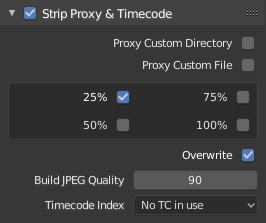代理
代理设置
参考
- 面板
- 存储
Defines whether the proxies are for individual strips or the entire sequence.
- 单个片段
Proxies are stored in the directory of the input.
- 投影
所有代理存储在一个目录。
- 代理目录
存储项目代理的位置。
- 设置已选中剪辑代理
Set proxy size and overwrite flag for all selected strips.
- 重建代理和时间码编号
Generates Proxies and Timecodes for all selected strips, same as doing .
片段代理/时间码
参考
- 面板

Once you have chosen the Proxy/Timecode options, you need to select all strips for which you want proxies to be built. Then use , or button in Proxy Settings panel. Once all proxies are built, they will be ready to use.
In order to use proxies, you have to select matching Proxy Render Size in the Sequencer preview Sidebar panel.
- 自定义代理
- 文件夹
By default, all generated proxy images are storing to the
<path of original footage>/BL_proxy/<clip name>folder, but this location can be set by hand using this option.- 文件
Allows you to use pre-existing proxies.
- 分辨率
Buttons to control how big the proxies are. The available options are 25%, 50%, 75%, 100 percent of original strip size.
- 覆盖
Saves over any existing proxies in the proxy storage directory.
- 品质
Defines the quality of the images used for proxies.
- Timecode Index
When you are working with footage directly copied from a camera without pre-processing it, there might be bunch of artifacts, mostly due to seeking a given frame in sequence. This happens because such footage usually does not have correct frame rate values in their headers. This issue can still arise when the source clip has the same frame rate as the scene settings. In order for Blender to correctly calculate frames and frame rate there are two possible solutions:
使用例如MEncoder的软件对视频进行预处理,修复文件头并插入正确的关键帧。
Use Proxy/Timecode option in Blender.
- 无
Do not use any timecode.
- 记录运行
Use images in the order they are recorded.
- Free Run
Use global timestamp written by recording device.
- Free Run (Rec Date)
Interpolate a global timestamp using the record date and time written by recording device.
- 无空隙录制运行
Record run, but ignore timecode, changes in frame rate or dropouts.
Note
Record Run is the timecode which usually is best to use, but if the source file is totally damaged, Record Run No Gaps will be the only chance of getting acceptable result.